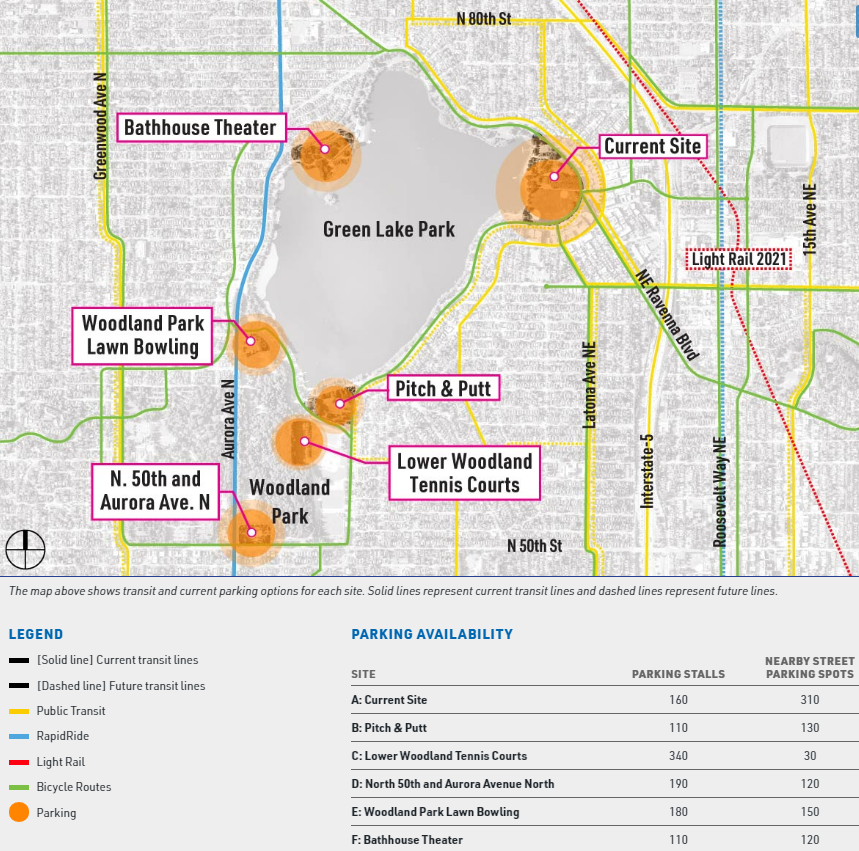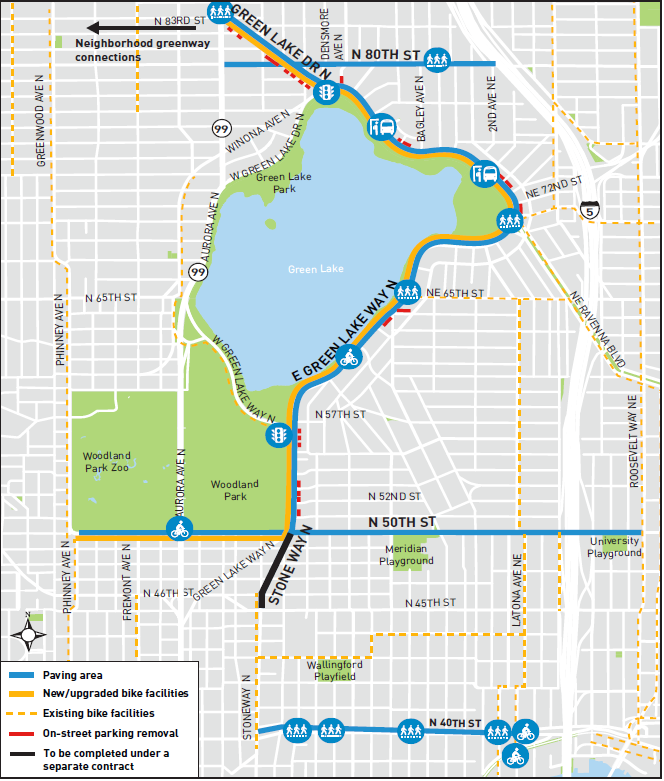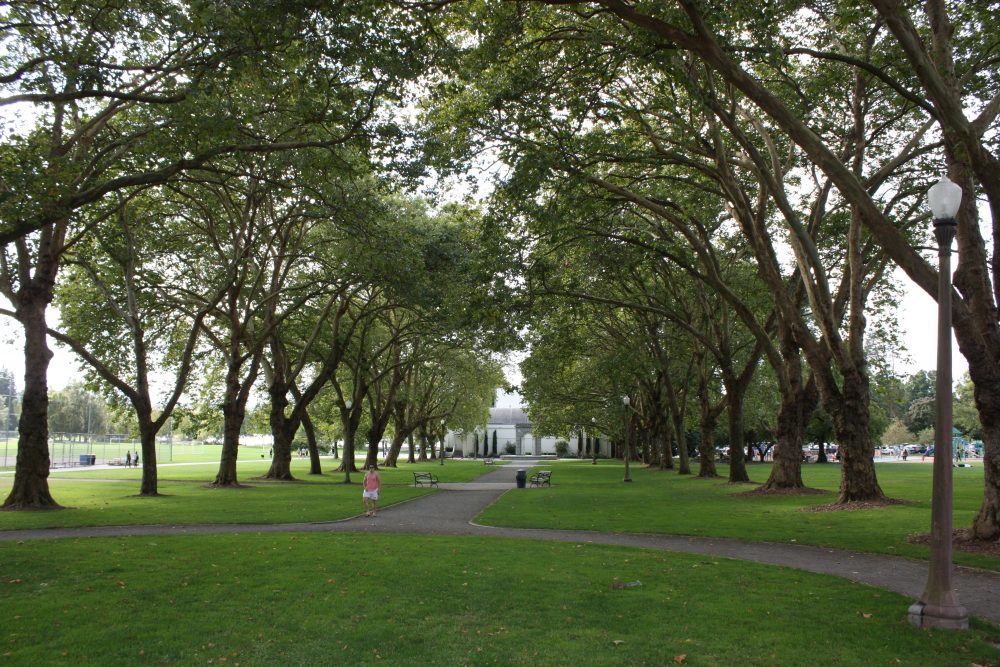In March, work began on site analysis and predesign for the Green Lake Community Center/Pool redevelopment. The existing community center is over 90 years old. Seattle Parks and Recreation intends on demolishing and replacing the old facility. Designs for a new community center are meant to meet the growing demand on one of Seattle’s most iconic parks.
This month, Seattle Parks and Recreation began their online open house and returned with six potential site options. The organization has identified the following sites:
- Site A: Current location
- Site B: Pitch & Putt
- Site C: Lower Woodland Tennis Courts
- Site D: Woodland Park Lawn Bowling
- Site E: N 50th St and Aurora Avenue N
- Site F: Bathhouse Theater

The criteria for site selection Seattle Parks is using includes accessibility for pedestrians, cyclists, and vehicles, and proximity to transit. Proximity to the lake, nature, and commercial areas also factor into the agency’s calculations.
Of the six sites, the City plans to select up to three for further study over the summer. On the project website, Seattle Parks is looking for community feedback to narrow down their choices. The survey will remain open until May 22nd.
A community’s center should be accessible to all modes of transportation. For the other sites to overtake the existing one, they should show they are up to the task. So let’s take a closer look at the transportation options at each site.
Transit Options
Solely based on transit options, the current site is my front runner among the potential site options. The site is most advantaged by its bus service–high-frequency Routes 45 and 62 pass close by. That advantage will only grow with the opening of the Roosevelt light rail station in 2021, which would put light rail only a 15-minute walk or six-minute bike ride from the existing site, according to Google Maps.
The wild card is the bus service restructure King County Metro is planning to coincide with the light rail extension. Generally bus frequency should go up, but Metro’s early proposal called for moving Route 62 farther away from Green Lake. New proposed Routes 23 and 25 would run on E Green Lake Way east of Meridian Avenue, but not at frequent intervals. Where Metro ultimately lands remains to be seen.
The other sites are within 10-minute walking distance from existing bus service, but it’s limited to one or two routes. That being said, relocation of the community center could provide the city a reason to increase bus services to the new site–not to mention consider land use and zoning changes to foster housing growth near these new services.

Walk and Bike
Green Lake’s iconic trail was first paved in 1970, increasing shoreline accessibility for people walking, rolling, and biking and providing a low-stress route through the area. Recently, Seattle Parks temporarily banned bicycling on the inner trail and declared it one way only to aid in social distancing during the pandemic.
Other sites also have fairly strong pedestrian and bicycle infrastructure, perhaps with the exception of Woodland Park Lawn Bowling site, which is a bit secluded and atop a hill. Theoretically, the project would come with multimodal improvements, but some disadvantages (like being shielded from population centers by the lake, Woodland Park, and Aurora Avenue) can’t be erased.
The existing site once again shines. Green Lake’s densest residential and commercial area has grown around the existing community center, granting it the most access to foot traffic. The location has paved walkways and is connected to a smattering of bike lanes, including the protected bike lane on Ravenna Boulevard that leads to Roosevelt and the U District.
Pedestrian and bike accessibility will be improving as well. E Green Lake Way will be receiving protected bike lanes, repaved sidewalk, improved and new curbs ramps, and new signals. This package of improvements is a part of the wider Green Lake and Wallingford Paving & Multi-Modal Improvements that the Seattle Department of Transportation (SDOT) is constructing.

Improvements for the Green Lake Way, Ravenna, and N 71st St intersection are perhaps the most important piece for the current site. The intersection was featured in Troy Heerwagen’s 2017 and 2019 contests for the worst intersections in Seattle. SDOT will be adding curb bulbs to the intersection, widening a sidewalk, and installing a rapid flashing beacon south of the intersection.
Land Use
Most of all, the existing site is next to density whereas the alternatives are tucked into park space and/or single-family zones. The Green Lake Urban Village is the only urban village adjacent to Green Lake and it’s right next to the existing community center. The edge of the Wallingford Urban Village is fairly close to the 50th and Aurora site, but not directly adjacent to it and the heart of Wallingford is farther to the east. There’s a narrow band of dense mixed-use zoning along Aurora Avenue, but not through the Woodland Park section.
We could hope to add or expand an urban village near the new site, but that would be an uncertain political battle and some of the sites are surrounded by park space that can’t be converted anyway. Being hemmed in by park space makes the Lower Woodland Tennis Court site and the Woodland Park Lawn Bowling site seem pretty hopeless for nurturing a new urban village.
Other considerations
Aside from the 50th and Aurora site, a new community center/pool will displace park amenities. The current site may be complicated if the old building qualifies for landmark status. Mobility and transportation improvements coming to the current site should be good enough to justify the displacement of parking, preventing the sacrifice of green space.
Soil stability may be the one flaw of the existing site. The current community center would be knee deep in water if Green Lake hadn’t been drained starting in 1911. This has raised suspicions about the stability of the current site, which is a lake bed covered in loose fill. The City has sent engineers to evaluate the soil at the current site and Pitch and Putt that is also covered in loose fill.
The original shoreline was close to Green Lake Way, so I’ve seen suggestions that a new community center be built on the current site, but on Green Lake Way. Perhaps money could be saved doing less foundation work.
Budget will have to factor into final site selection and design. With the Covid-19 lockdown induced budget shortfalls, it is reasonable to want to limit the scope of the project. It’s also reasonable to question the need for a new Green Lake community center, when other parts of the city and two notable bridges could use the money.
For context, the last community center/pool built in the city was in Rainier Beach and cost roughly $35 million in 2013. Construction of the new facility is projected to start in 2024, and 2021 is when the City expects to start exploring funding options. I’d hope that we’d be coming out of the epidemic and associated economic recession by then. That being said, the age and popularity of the park may help it win funding even if the economy is still sluggish.
Infrastructure opportunities like what community center offers has historically been a part of economic recovery packages. If you dig into the history of much of Green Lake and much of Seattle’s park infrastructure, you’ll find that they received monies from the Works Project Administration that helped the country recover from the Great Depression.
Also, south Green Lake won’t be missing out on any redevelopment action. A combination of private, state, and City money has funded the construction of the new Green Lake Community Boathouse, slated to begin later this year. The new boathouse will replace the existing Green Lake Small Craft Center.
Ranking the Sites
The Front Runner: Current Site – Best transit, bike, and pedestrian access. Right next to Green Lake Urban Village.
A Distant Second Place: 50th and Woodlawn – Fair access to transit and bike infrastructure. Walking distance from Wallingford and Upper Fremont. Major downside is that it’s very detached from Green Lake.
Sites to consider
Pitch and Putt – Limited transit options, fair access for bicyclists and pedestrian. Walking distance from Tangletown commercial area.
Bathhouse – Some transit options, no bike infrastructure, and limited pedestrian access. Access to Aurora and North Green Lake commercial areas.
Sites to eliminate
Lawn Bowling – Weak transit, bike, and pedestrian access. The most awkward and isolated location for all transportation options.
Lower Woodland Tennis Courts – Weak transit options, fair access for bicyclists and pedestrians. Residential and Commercial are the most distant for this site. Somewhat detached from the lake.
An Urbanist Wishlist
On top of trading parking space for the footprint of a new community center, I have a couple more items that I’d like to see in a new facility. A small bike parking garage could be an interesting demonstration of bike infrastructure uncommon in the states.
Solar orientation is mentioned quite often on the project’s website, so solar panels would be a strong addition to the project. If there’s budget, solar panels pair well with a microgrid (be on the lookout for an article about that), like the one planned for the Miller Community Center.
2026 is when the City hopes that new Green Lake Community Center will be completed, by then the Seattle metropolitan area will be more connected than ever. A Green Lake Community Center could champion transportation and green energy initiatives that the City has been working toward. The center could be a symbol of recovery and forward thinking, and I hope it will be.
Once again, you can take the survey here.
Shaun Kuo is a junior editor at The Urbanist and a recent graduate from the UW Tacoma Master of Arts in Community Planning. He is a urban planner at the Puget Sound Regional Council and a Seattle native that has lived in Wallingford, Northgate, and Lake Forest Park. He enjoys exploring the city by bus and foot.


